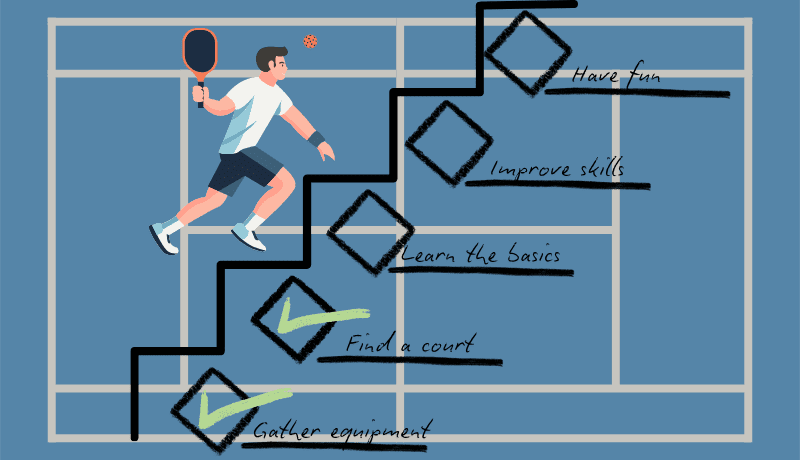Development of lists and checklists
Lists and checklists change over time to better achieve their goals. But the goals are also changing. Let's look at the work of this changeable mechanics in this article.

The blog “So List” started with an article about the goal of a list. Sometimes this goal is to preserve some knowledge, sometimes it is to guide the list user through a series of actions to a valuable result. It might seem that in this pair, tool and goal, there is something permanent — the goal — and something variable — the tool for achieving it. But both parts are dynamic.
Today, I propose to look at this dynamism using the example of my book reading checklist. This checklist appeared back in 2017, so it is about 7 years old. Over the past years, it has undergone significant changes. Sometimes these changes occurred because the checklist poorly helped in achieving the set goal. And occasionally the goal itself changed, briefly expressed as the qualitative reading of a book.
The mechanics of my work with books are as follows: I take an interesting book, then create a dedicated folder in an electronic organizer. I add the already mentioned checklist there and follow it until the book is read.
So, the checklist in its first version from 2017:
☐ Read “Book X” | By September 1
└ ☐ Read NN pages of “Book X” | Every day
☐ Adjust the reading speed of “Book X” | Next SundayThe goal of this checklist is to read the book cover to cover as quickly as possible, while becoming smarter in the studied topic.
There are three tasks in the checklist. The top task is the pinnacle of activity, the read “Book X”. I would like to achieve it by September 1. A read book in this checklist is when the eyes have passed over all the pages from cover to cover. Possibly, along the way, some especially catchy text will appear, which I will highlight.
Below the task is a subtask that defines daily actions. Thanks to it, I step forward. Before starting to read, I set a desired number of pages to read per day based on experience. For example, 12.
The third task is needed to adjust the number of pages read daily after getting acquainted with the book. If I do not manage to read 12 as I would like, I can set 10.
About six months later, it became clear that simply reading from cover to cover was not enough. The books often contained references to external materials. In those years, I read books in the subway using an e-ink reader. There was no way to immediately go online and delve into what sparked my interest. Moreover, wanting to achieve the set daily goal in the number of pages, I could not be distracted by something external. Tasks to view this or that material in the future began to pile up in the already mentioned folder of the electronic organizer.
Tasks to view materials had no specific dates, they were safely forgotten. The debt to myself accumulated, and there was no feeling of achieving the already expanded reading goal. The result of this “crisis” was the appearance of a new task in the checklist:
☐ Set a date to view the materials of “Book X” | September 1As you can see, the due date for this task is set on the same day when the book is expected to be read. This seems most appropriate since memories of the read are still fresh.
In the next 2019, I read several more books, including “Pragmatic Thinking and Learning” [1]. In this book, for working with text, the author suggested using the SQ3R technique [2].
SQ3R stands for Survey, Question, Read, Recite, Review. This is an algorithm of actions for working with the text. I added it to extract even more knowledge from the book:
☐ Do SQ3R for “Book X” | Before starting to read “Book X”It seems great to read a book every day. This way you can read many things and probably become a smart person. But is it enough to add a task to the organizer to henceforth be a daily reader? It seems not. Otherwise, everyone would do so. I cannot say that I have found a foolproof solution to the problem, but if you attach a task to a specific time, for example, at 8:00, the chances increase. The main thing is not to add anything else at 8:00. Here's how it looks:
└ ☐ Read NN pages of “Book X” | Every day at 8:00It's good when there are methods developed by someone in your activity. It appears that the activity immediately becomes more substantial, supported by theoretical achievements. Even better when the activity has a resounding abbreviation like SQ3R. Here, everything seems to come together. However, it's a bit disappointing when you don't really understand what exactly applying these methods gives.
That is, the bureaucracy from the application of SQ3R has increased, but the feeling of any gains has not appeared. I twisted the tasks this way and that to try the method again, but alas. At some point, the checklist completely got rid of it.
I saw other methods helping to extract more from the book. The problem is that it's unclear why extract more from it. Of course, it's bad when it feels the same whether you read it or not. It's another thing when you read, refracted through your system of views, adjusted them, and applied what is possible to apply. But is there something more to take?
Although the daily action now has its time, there is still something very capricious in it. The capriciousness is in setting the exact number of pages. It seems to be a roughly predictable daily volume, what kind of capriciousness are we talking about? After a few years, it became clear that the text is rather relief than flat. Today's 12 pages and tomorrow's may be entirely different.
In its simplest form: some pages may be illustrations, they do not need to be read, and the desired NN pages are achieved quickly. And if there are no illustrations, the paragraphs are large, it may turn out that there is much more text than usual.
There is also a situation where the text is easy, e.g., some evidence and anecdotes to support the idea. And there are significant moments when the best action is to stop reading and start thinking. This already contradicts the task of reading a fixed number of pages.
The checklist already has a task to sort out the external materials referenced by the book. But it may happen that it is not possible to deal with them in one go. Moreover, the desire is already somehow less: I read the book, started another. How about dealing with external materials while reading the excerpts that mention them? How can this be done if the goal is to read NN pages?
I couldn't give myself an answer to this question, but I could understand that the number of pages read per day is far from being in my power. What I can do more confidently is to allocate a certain amount of time to work with the book:
└ ☐ Spend 30 minutes reading “Book X” | Every day at 8:00Today I may have managed to read 7 pages, tomorrow 15. The number of materials to view after the book is less, the immersion is deeper. And I no longer need to adjust the reading speed of the book, this item is removed. The expected date of reading the book also no longer makes sense.
You might think that I will completely slack off and read one page a day since there is no longer this boundary. Firstly, it was not there before, as I set the reading speed myself. Secondly, the oppressive feeling of the abundance of untouched books will soon catch up with my inner lazy person.
What books did I read 5 years ago? I want to remember to recommend to a friend today. I need to write down this information somewhere. So, I write it down in a special service if I don't forget to do so. What can I do to ensure this action? I can add tasks for this and get roughly the following book reading checklist:
☐ Add information about the start of reading “Book X” to the book accounting system | Before starting to read “Book X”
☐ Read “Book X”
├ ☐ Add information about completing “Book X” to the book accounting system
└ ☐ Spend 30 minutes reading “Book X” | Every day at 8:00
☐ Set a date to view the materials of “Book X”This is roughly what this checklist looks like today. And what is the goal now? I will formulate it in general terms as follows:
- Discover successful opportunities to transform the outlook on life or job.
- Identify moments that can be used to improve the quality of life or job now and plan their implementation.
- Mark parts for possible future use.
- Find hooks for new books.
It seems that significant changes have occurred relative to the initial goal of “reading everything from cover to cover as quickly as possible to be smarter.” The same significant changes affected the tool of the checklist itself.
Can I say that I am satisfied with myself and do not see ways for further development of either the goal or the tool? Absolutely not. Recently, reading Peter Kump's “Breakthrough Rapid Reading” [3] caused a new wave of reflections. I was especially hooked by the point about choosing a reading style depending on the goal set. For example, you can read only the headings to get acquainted with the content of the article and decide whether to dive deeper. The same reading but more effective. Do I know how to do this with books? Not yet.
On the other hand, will the goal set for my reading really bring me the most? And what is this “most”?
Today's article turned out to be quite large, thank you for reading. The development of lists and checklists occurs together with their goals, they waltz relative to each other, transforming as experience accumulates.
List of links:
[1] Andy Hunt, “Pragmatic Thinking and Learning: Refactor Your Wetware”, ISBN 978-1-934356050
[2] SQ3R from Wikipedia
[3] Peter Kump, “Breakthrough Rapid Reading” ISBN 978-0-735200197



